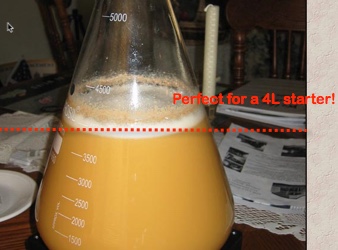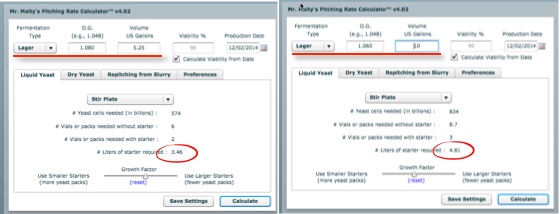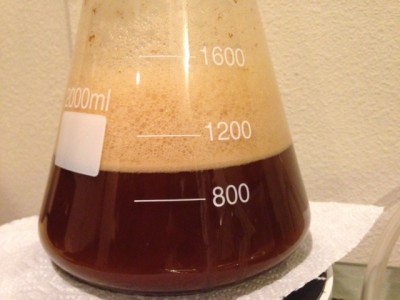With Black Friday just behind us, I’ve got a lot of new brewing toys that I want to write about. One of the things I purchased online this year was a 5000 ml Erlenmeyer Flask. The funny thing is, when I bought my first yeast starter kit, they included a 500 (two zeros) ml flask.
5000 ml seemed insane at the time. Now, it's my go-to container for yeast starters.
But will you really need to make a 5 liter yeast starter? Maybe yes.
Do you really need a 5000 ml flask? If you're making 5 gallon batches of beer, yes.
==> Get It For Cheap on Amazon
Let's dig in and look at why.
Table of Contents
Big Flasks For Big Starters
If you have never made a yeast starter, then you need to know that yeast starters make better beers. The way I understand it is that you are basically giving the yeast an appetizer, i.e. getting them started and ready to eat your wort.

Then they’ll ferment your beer beer more efficiently, creating fewer off flavors.
Part of the reason they ferment more efficiently is because you are growing the yeast population.
Technically, 1 vial of liquid yeast can ferment a 5 gallon batch of beer. I did it before, with my Orange Clove Wit (before I knew what I was really doing). The beer fermented, and it was good.
However, you can grow your yeast population, reducing the amount of work they have to to to fully eat up all the sugar in your wort by doing a starter.
The typical starter for a 5{a60bef903c54612bed20edb95d22500dcc3da56ac2b90be5eb4391998d03cdd5} ABV ale is going to be a 1 liter starter. That means you have 1 liter of water and 100 grams of dry malt extract (or app 3/4 cup). Though a 1l starter could fit in a 1l flask, using a 2l flask give you room for any overflow that may happen (see below). Filling any liquid vessel right to the top is asking for trouble in my opinion!
So when you decide to start doing bigger beers (higher ABV), or lagers, which require more yeast due to lower fermentation temperatures, the required size of your starter starts to grow.
2-5 gallon starters are not uncommon. Once you start brewing more than 5 gallons of beer, then you start to get into not only larger starters, but using more than one yeast packet in your starter.

You can calculate this all out at Mr Malty, but just know, that there will probably come a day when you actually need a 5000 ml Erlenmeyer flask.

Erlenmeyer Flasks VS Other Containers
Now, you may be thinking, well if I need to get something that big, why don’t I just use a 1 gallon jug, a 3 gallon carboy, or a growler?
These types of vessels can work, and do for many that simply don’t want to spend the money on equipment. However, there are several reasons why an Erlenmeyer flask is superior to anything else.
- narrow neck makes it easy to carry
- narrow opening means less chance of unwanted debris or microbes getting in
- shaped specifically for keeping liquid in (no splashing out)
- wide bottom means high surface area for more oxygen exchange (yeast love oxygen)
- wide bottom also means less chance of knocking over
- borosilicate glass is heat proof (you can heat your wort on a gas stove)
- flat bottom for stir plates + stir bars
The combination of all these elements means that this type of container is perfect for what we need.
The Cheapest Place To Get 5000 ml Flask
I was pretty surprised to find out the huge range of prices on these things. I almost bought one from Norther Brewer, but decided to price shop because $70 + $8 shipping seemed high for a piece of glass, regardless of how big it is.
I found it on Amazon, but the price changes from time to time. It's about $30 to $40 plus shipping.
I also found a cheap 5000ml flask on More Beer but total cost will depend on where you are. It’s $40 + $7.50 shipping to where I am, for a total of about $48. You can even get free shipping for orders over $59.
Other Things To Consider
1. A vessel this big is great not just for 5l starters, but anything above 2l would be perfect for this size IMO.
2. If you have a stir plate already, consider that this flask quite large. The diameter of the flat part of the base is about 8 inches wide and if you include the rounded part, the diameter is between 9.5 and 10 inches.

If you have one of those small box stir plates, it may be susceptible to tipping over. I use a Vortex 2.0 stir plate (now unavailable) and it works great. Although it’s slightly smaller than the diameter the flat, round design of the plate means zero risk of tipping.
It also means you don’t have a gigantic piece of equipment to store.
3. Consider using a bigger stir bar with a volume of liquid this high. I used a small stir bar and had to turn my plate on full blast to get a vortex going in 5l of water. Even then, it wasn’t a stable vortex and seemed to splash a lot. I've currently got a 1-inch bar in the mail and will update with the results.
Update: With the big stir bar it banged around a lot more and was harder to get it to spin correctly without throwing the bar. I was able to get a better, smoother vortex going, and would just have to put it out of the way so I didn't hear it.
The biggest started I made in my 5L flask was a 3L+ starter for my Russian Imperial Stout and Double Red Ale.. Performance was normal and acceptable. I didn't get a great vortex going, but the liquid was spun and it kept the yeast in suspension. The 5L container is great for making big beers.
Great info, thanks. I had already decided I needed a 5L flask for starters…
Does anyone use a boiling flask or have any experience with a boiling flask vs an Erlenmeyer flask? Thx.
I wonder if the boiling flask neck is going to be too skinny to release sufficient co2, but that’s probably not an issue. The main issue is probably the shape, which is not as flat on the bottom, and may be prone to falling over. Also, it may interfere with your stir bar if you’re using a stir plate.